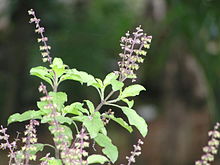Our website is made possible by displaying online advertisements to our visitors.
Please consider supporting us by disabling your ad blocker.
Ocimum tenuiflorum
| Ocimum tenuiflorum | |
|---|---|

| |
| Scientific classification | |
| Kingdom: | Plantae |
| Clade: | Tracheophytes |
| Clade: | Angiosperms |
| Clade: | Eudicots |
| Clade: | Asterids |
| Order: | Lamiales |
| Family: | Lamiaceae |
| Genus: | Ocimum |
| Species: | O. tenuiflorum
|
| Binomial name | |
| Ocimum tenuiflorum | |
| Synonyms[1] | |
| |
Ocimum tenuiflorum, commonly known as holy basil, tulasi or tulsi (from Sanskrit), is an aromatic perennial plant in the family Lamiaceae.[2][3] It is widely cultivated throughout the Southeast Asian tropics.[1][4][5] It is native to tropical and subtropical regions of Asia, Australia and the western Pacific.[1] This plant has escaped from cultivation and has naturalized in many tropical regions of the Americas.[3][6] It is an agricultural and environmental weed.[3]
Tulasi is cultivated for religious and traditional medicine purposes, and also for its essential oil. It is widely used as an herbal tea, commonly used in Ayurveda, and has a place within the Vaishnava tradition of Hinduism, in which devotees perform worship involving holy basil plants or leaves.
- ^ a b c d "Ocimum tenuiflorum L." Kew, Royal Botanic Gardens. 2023. Retrieved 26 June 2023.
- ^ "Ocimum tenuiflorum". Germplasm Resources Information Network. Agricultural Research Service, United States Department of Agriculture. Retrieved 7 July 2021.
- ^ a b c "Ocimum tenuiflorum (holy basil)". CABI Invasive Species Compendium. 23 August 2014. Retrieved 26 June 2023.
- ^ Staples, George; Michael S. Kristiansen (1999). Ethnic Culinary Herbs. University of Hawaii Press. p. 73. ISBN 978-0-8248-2094-7.
- ^ Warrier, P K (1995). Indian Medicinal Plants. Orient Longman. p. 168. ISBN 978-0-86311-551-6.
- ^ "Ocimum tenuiflorum". Integrated Taxonomic Information System. 26 June 2023. Retrieved 26 June 2023.
Previous Page Next Page


